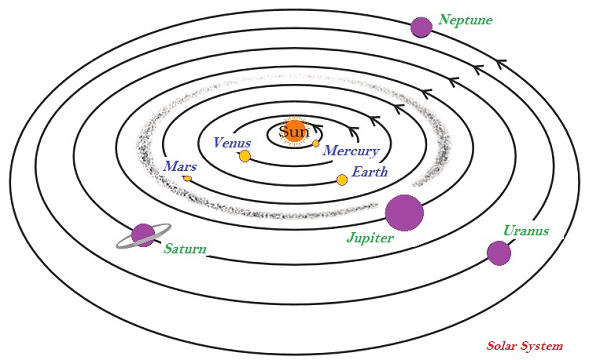Solar System Notes: Free Notes of Geography GK Short Tricks of Solar System in Hindi
Geography Short Notes For Competitive Exam, Topic-Solar System | For UPSC, SSC, State and Other Exams
Master your aggressive assessments with carefully crafted handwritten notes on the Solar System. These concise and comprehensive notes cover every astronomical frame, from the solar to the farthest reaches of our galaxy. Perfect for college student, Aspirants preparing for exams, these notes provide clear explanations, illustrations and key standards to improve your knowledge. Simplify your investigation process and boost your confidence with expertly curated sources. Whether you're aiming for the highest ratings or striving for a deeper knowledge of astronomy, these handwritten notes are your perfect partner. Start your adventure today with our Solar System Notes for Competitive Assessment!
Today we will provide you important notes of Geography written by student who are preparing for competitive exams. Handwritten notes for upcoming competitive exams like upsc, ssc, railway, bank, defense exam and other TET or teachers exams.
Some Most Important Questions about our Solar System for competitive Exams
These are most important Questions for competitive exams | Try to solve it!
Full moon once a month and that night is called as __
- a) Amavasya
- b) Poornima
- c) Half Poornima
- d) Half Amavasya
(Correct Answer:- b)
Poornima is also called as ___-
- a) Half Moon Night
- b) New moon Night
- c) Full moon Night
- d) Old Moon Light
(Correct Answer:- c)
Celestial Bodies that have their own heat and which emit light in large amounts is called as ___--
- a) Constellations
- b) Android
- c) Stars
- d) Planets
(Correct Answer:- c)
Which of the following is considered as Star--
- a) Earth
- b) Sun
- c) Moon
- d) Galaxy
(Correct Answer:- a)
Which one option in following is true about Sun-
- a) It is made up of gases
- b) It has its own heat and light
- c) Sun is a star
- d) All of the above
(Correct Answer:- d)
Which one is following called ‘dwarf planet’-
- a) Saturn
- b) Jupiter
- c) Mars
- d) Pluto
(Correct Answer:- d)
The diameter of Moon is ____ that of the earth-
- a) ½
- b) 1/3
- c) ¼
- d) 2/3
(Correct Answer:- c)
Which one in following planet is known as blue planet-
- a) Mars
- b) Mercury
- c) Venus
- d) Earth
(Correct Answer:- d)
Sun, The moon and all those objects shining in the night sky are called __-
- a) Shining Earth
- b) Celestial Bodies
- c) Astrological Satellites
- d) Shining Satellites
(Correct Answer:- a)
The different group of stars is known as-
- a) Constellations
- b) Celestial bodies
- c) Asteroids
- d) Comet
(Correct Answer:- a)
Also read these notes
[pdf*] भारत में सबसे बड़ा, ऊँचा और लंबा– General Knowledge GK
[pdf] पर्यावरण प्रश्नोत्तरी नोट्स सभी प्रतियोगी परीक्षाओं के लिए | Free Environment PDF
[PDF*] World desert name list in hindi For Competitive Exams | विश्व के रेगिस्तान
The following constellation consists of seven main stars-
- a) Ursa major
- b) Ursa minor
- c) Hercules
- d) Lyra
(Correct Answer:- b)
The ‘Pole star’ is-
- a) North star
- b) South star
- c) East star
- d) West star
(Correct Answer:- a)
Moon moves around the earth in about _____ days-
- a) 25
- b) 26
- c) 27
- d) 28
(Correct Answer:- c)
Moon takes ___ days to complete one spin-
- a) 25
- b) 26
- c) 27
- d) 28
(Correct Answer:- c)
Majority of asteroids are found between the orbits of--
- a) Mars and Jupiter
- b) Earth and Mars
- c) Jupiter and Saturn
- d) Saturn and Uranus
(Correct Answer:- a)
Which one following planet has maximum number of moons--
- a) Jupiter
- b) Saturn
- c) Uranus
- d) Neptune
(Ans:b)
Which one planet takes maximum time for one spin on its axis--
- a) Venus
- b) Mercury
- c) Saturn
- d) Uranus
(Correct Answer:- b)
Planet takes maximum time for one orbit around sun-
- a) Neptune
- b) Mercury
- c) Saturn
- d) Uranus
(Correct Answer:- a)
Which one planet takes minimum time for one orbit around sun-
- a) Mercury
- b) Earth
- c) Mars
- d) Venus
(Correct Answer:- a)
The following planet(s) has(have) ring around it(them)-
- a) Jupiter
- b) Saturn
- c) Uranus
- d) All of the above
(Correct Answer:- d)
The sun is __ million km away from the earth-
- a) 100
- b) 150
- c) 200
- d) 250
(Correct Answer:- b)
Correct ascending order of distance of planets from sun is-
- a) Mars, Earth, Jupiter, Saturn
- b) Earth, Mars, Jupiter, Saturn
- c) Earth, Mars, Saturn, Jupiter
- d) Earth, Jupiter, Mars, Saturn
(Correct Answer:- a)
Which one is following planet is considered as ‘Earth’s-twin’-
- a) Mars
- b) Mercury
- c) Venus
- d) Saturn
(Correct Answer:- c)
Following planet is nearest to the Sun-
- a) Mars
- b) Mercury
- c) Venus
- d) Saturn
(Correct Answer:- b)


![[Handwritten] English Grammar Complete Notes Free pdf | हाथ से लिखे बेहतरीन नोट्स](https://blogger.googleusercontent.com/img/b/R29vZ2xl/AVvXsEj3h_XnO8OyhboujskxIgtOw9dLrg_zJ1PY8wtzCZzfY0pAUfU91f4P_a6S5HPQT5laqR1QEf7tJIfsWU2tx9LgMqN_pGpXydNI2FNmR19-QRh3N9RiAF19JW8SEqLmqC1nhcg7HpBQz3DK/w72-h72-p-k-no-nu/Handwritten++English+Notes.jpg)

0 Comments